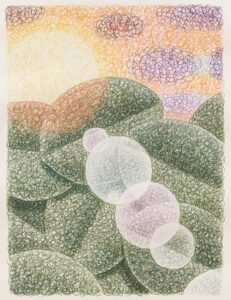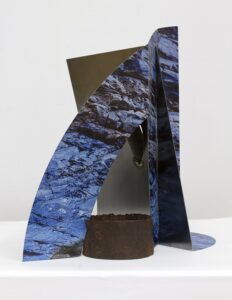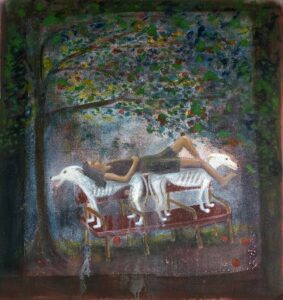Gaa Gallery’s current exhibition presents the work of 17 contemporary artists, many of whom have never before been shown in Provincetown. Curated by Gavin Kennedy, the exhibition offers materially rich objects from an international roster, but the mood is both local and seasonal. The show’s title, “Summer Escape,” sets the tone, and the artwork — much of it colorful and tactile — follows suit. In these images, forms dissolve into atmospheric hazes, colors vibrate against each other, and figures luxuriate in beautiful surroundings. The gallery space reverberates with the indulgent atmosphere of a Provincetown summer or a dreamy day at the beach.
Laurens Legiers, Untitled (green leaves with a sun glare)
Laurens Legiers, born in 1994, left this piece untitled with only a brief description to enlighten the viewer: “green leaves with a sun glare.” But I don’t see green leaves — I see a portrait of an alien landscape: bulbous, feather-light hills and valleys; aggressively silly purple clouds; a glaring sunset behind it all. The transparent whitish train of bubbles (Legiers’s “sun glare”) is some unfamiliar cryptid shaped vaguely like a caterpillar. It crawls or floats toward the sunset like the hero at the end of a movie.

Legiers lives and works in Antwerp, Belgium. His art draws on the principles of Romanticism. As an enthusiastic music history professor at Oberlin explained it to me, there is one way to effectively define that era: “the infinite.” Romantic-era composers like Beethoven and Schumann strove to create music that defied lingual definition. Legier’s untitled piece feels infinite in some ways, drawn only with fine swirls of colored pencil. There is empty space behind each “green leaf,” underneath every cloud, and behind the pale sun.
The leaves should make some sound as they jostle in their inflated state, but the paper is silent; I can imagine any infinite sound. The “sun glare” reflects in an indefinite dimension. If I choose to believe I’m looking at green leaves with a sun glare, I might choose to believe that I am smaller than a leaf. In that case, the world becomes more infinite than ever. —Dorothea Samaha
Lumin Wakoa, Spring in Ahawith Chesed Cemetery
Next to the larger pieces exhibited in the gallery, Spring in Ahawith Chesed Cemetery seemed demure. At 11 by 14 inches, done with oil on linen over panel, the work didn’t have the flashiness or grandiosity of its neighbors. But sticking my nose closer to Lumin Wakoa’s painting, I became entranced by the wild movement of the pink and purple flower bush and the tall tree stretching overhead. Their shapes, so clear from a distance, dissolved into blurriness and three-dimensional texture. I saw flecks of pink against the tree’s dark green visage and shadows of dark green under the flower bush’s vivid pinks. The gravestones remained still — their lines were crisper and their gray tones more solid. Wakoa paints bright life not against but next to the stillness and peace of death.

Looking at Wakoa’s other work on her website, I notice a theme of flowers and symbols of death. Skulls sit surrounded by color. The texture looks tactile. She paints in small strokes, which add to the sense of movement in her work. A lot of her work seems more abstract than Spring in Ahawith Chesed Cemetery, which she painted in 2023. Maybe she’s trying a new approach.
I want to know what’s behind the bush and the gravestones and the tree. Subtle shadows lingering in the background make the small landscape seem expansive. Though the piece is crowded with color and objects both animate and inanimate, I have a sense of space. I’m just passing through, and this painting is my glance to the right. —Eve Samaha
Letha Wilson, Death Valley Mosaic Canyon
The title of Letha Wilson’s sculpture, Death Valley Mosaic Canyon, appears to be contradictory. “Death Valley” suggests desolation, while “Mosaic Canyon” evokes vibrant colors. The conflict is evident in this piece: bright blues awkwardly intersected by a corroding metal pylon.

Wilson’s sculpture captivates by blending industrial and natural imagery through mixed mediums, showcasing a landscape shaped by human presence. She typically employs photography — here, images from her travels across the American West — to generate pieces that immediately evince interaction between manmade objects and natural surroundings.
Before visiting the Gaa Gallery’s “Summer Escape” show, I had spent the day reading about and viewing photos of the wildfires in Maui, Hawaii. Flames had ravaged the landscape, leaving metal poles amid incinerated homes and smoldering car frames — the sole reminders that people once lived there.
Upon seeing Wilson’s sculpture and the interplay between landscape imagery, tangible sculpture, and human-made materials, I remembered those images of destruction. Human interventions melded into her sculpture, just as homes integrated into Maui’s topography as ashen infiltrations, human remnants blended with the earth.
Despite the wildfires, new growth will emerge. Ashes will fertilize the soil, giving rise to wildflowers. Wilson’s sculpture left me with hope: amid a scarred landscape, vibrancy and vitality could sprout in the aftermath of devastation. —Georgia Hall
Johanna Robinson, An antidote to hostile architecture (Greyhounds)
Greyhounds, bright white and translucent, so thin I can count their ribs, stand on a bench that has evenly spaced armrests. The armrests suggest an Americanized version of “comfort”: “personal space.” But really, they disrupt the seat of the bench and make it impossible for anyone to lie down.

A woman reclines on the backs of the greyhounds, appearing weightless. The piece feels dreamlike — a vision of medieval color and silhouette, questionable physics, and unquestionable physicality. Is the woman comfortable atop the dogs’ spiny backs? Are their delicate legs strong enough to support her? Everyone seems entirely at ease with this modest proposal.
Maybe the woman is contemplating the cruel absurdity of hostile architecture. Or maybe she’s thinking about the loyalty of dogs. —Dorothea Samaha
Reverberations
The event: Group exhibition: “Summer Escape,” Part II
The time: Through Sept. 30
The place: Gaa Gallery Provincetown, 494 Commercial St.
The cost: Free



